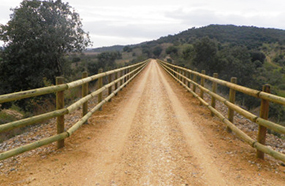TRAGSA restores the former railway track of the Vía de la Plata as a natural path
22 March 2016 | Madrid

- This consists in the first section of this road put into service for its pedestrian and cyclist use, with the goal of promoting rural development
The project for the restoration of the Vía de la Plata (the Silver Road) has been developed by TRAGSA for the Deputy Directorate-General for the Promotion of the Rural Environment, which is attached to the Directorate-General for Rural Development and Forest Policy in the Ministry for Agriculture, Food and the Environment (MAGRAMA).
The works have been focused on the recovery of the former railway track of the line of the Vía de la Plata for its use as a Natural Path, promoting its development as a leisure and rural area.
A number of works have resulted in the recovery of part of the former railway track of the line Vía de la Plata, adapting it to be used as a Natural Path and integrating it into the Natural Paths Network of Spain.
An old Roman road
This path has its origins in the Roman road which went through Spain from South to North, starting in the modern city of Mérida and ending in the town of Astorga. Through these works the goal was recovering the value of this infrastructure, up to now forgotten, for the municipalities through which it goes along.
The restored section is located between the municipalities of Alba de Tormes and Carbajosa de la Sagrada. With a total length of more than 20 kilometers and 8 kilometers from the City of Salamanca, it goes through the above mentioned municipalities, besides those of Terradillos, Calvarrasa de Arriba and Arapiles.
This is the first section of the Natural Road of the Vía de la Plata which is put into service for its pedestrian and cyclist use, with the goal of promoting rural development, putting the user into a closer contact with a highly interesting natural and cultural environment.
TRAGSA and Grupo SEPI
TRAGSA belongs to Grupo SEPI, a corporate holding which includes a total of 16 state-owned companies in which it has direct, majority shareholding participations, with a workforce of around 73,000 professionals in 2014; the Spanish state-owned television and radio corporation, Corporación Radiotelevisión Española, which is attached to SEPI, and one public foundation. Equally, SEPI has direct minority shareholdings in a further ten companies, and indirect shareholdings in more than one hundred companies.







